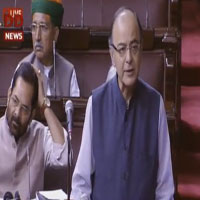GST bill tabled in Rajya Sabha
Inching closer to India’s biggest tax reform becoming a reality, Finance Minister Arun Jaitley today tabled the Goods and Services Tax Bill in the Rajya Sabha.
As a result of government’s continuous efforts to get political parties on board, the Bill is expected be passed in the Rajya Sabha with the support of opposition parties where the government doesn’t have numbers in its favour.
In his introductory remarks while tabling the amendment bill in the upper house the Finance Minister said that government wanted a wider political consensus on GST bill.
Finance Minister enlisted the benefits of the GST Bill for the economy and the states saying it will empower them and will increase revenue of states as well as Centre.
Finance minister said that GST Council is in line with the federal structure of governance in the country.
The goods and services tax will be the single most powerful tax reform that India will see.
The objective is to end the regime of multiple taxes on goods and services and bring them under one rate.
Along with bringing about a semblance of uniformity in taxes across states, this is expected to increase efficiency and compliance in the system doing away with complexities.
The biggest advantage of GST is economic unification of India.
It has potential to end the long-standing distortions arising out of the differential treatment of the manufacturing and service sectors.
The several types of taxes that currently exist in the country will be subsumed by GST and these different taxes would come under the GST umbrella.
Since this would eliminate double taxation, it might result into fall of prices; thus relieving consumers.
GST provides tax credit at every stage of taxation from manufacturing to consumption.
This would result in better tax compliance of industry, trades and businessmen.
For businesses, the GST would make life easy because of easier compliance due to absence of multiple taxes and easier return filing, tax payment and refund process due to robust IT infrastructure.
The GST with its uniform taxation structure can be one of the most important steps towards achieving higher GDP growth.
The current indirect tax regime suffers from significant cascading which leads to higher cost of goods and services consumed in the country.
The reduction of transaction costs in India would make our products more competitive in the international market thereby not only increasing the GDP of the country but also inflow of foreign currency.
There are also estimates that GST can add 1.5 – 2% to GDP.























